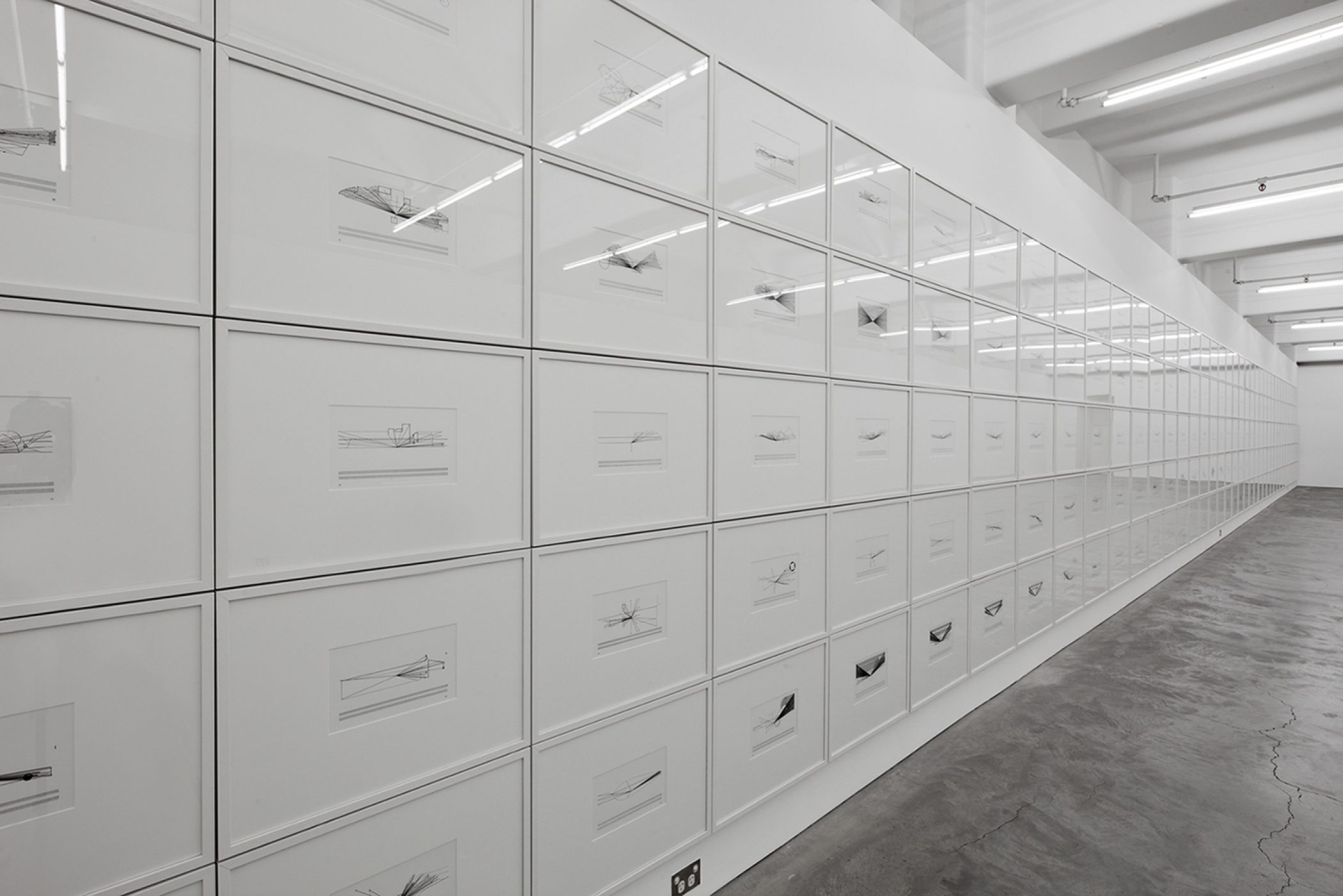Marco Fusinato
Mass Black Implosion (Treatise, Cornelius Cardew)
9th October – 16th November 2013
Anna Schwartz Gallery
Marco Fusinato’s works are almost always serial, as if demonstrating a thesis, using a set of rules as ‘controls’ for experimentation. Certain parameters are applied to the given source material, and the results displayed non- hierarchically as objective data. While Fusinato withholds his own interpretation of these images and objects, the material itself plainly indicates the artist’s interests in the potential overlap of cultural production and radical politics.
In his ongoing series Mass Black Implosion (2007 – ) Fusinato takes scores by avant-garde composers, drawing lines from each original note to a chosen point. The completed drawings act as propositions for new noise compositions, or moments of extreme consolidation and intensity, as if every note were played at once.
Over the past five years of the Mass Black Implosion series, Fusinato has engaged with works by John Cage, Iannis Xenakis, Béla Bartók, Percy Grainger, Yves Klein, Glenn Gould, Anthony Pateras and others. The parameters of this body of work are straight-forward: each drawing is comprised of a facsimile of the full score of the selected piece of music; the format of the original publication is retained so that each page of the score is an individually-framed drawing, installed according to the original pagination; each note on a page is connected by a straight line to a single point that Fusinato designates arbitrarily. A full work might be a single page, or in the case of ‘Mass Black Implosion (Treatise, Cornelius Cardew)’, 193 pages installed together, in this iteration, in a bloc along one wall.
Another commonality between the works in Mass Black Implosion is evident: each composer that Fusinato ‘plays’ is a leading figure of the Twentieth or Twenty-first Century musical avant-gardes; each one is a rule-breaker. Submitting the works of these radical, and often radically different, composers to a rigorous system of compliance, Fusinato occupies and transforms these existing works from explanations of sound-over-duration, into a statement of sound-as-event. To borrow terms from another of Fusinato’s modes of production, the Mass Black Implosions are instances of appropriation with distortion and amplification.
Fusinato’s adoption of Cardew’s Treatise for this exhibition is a particularly important moment in the series. The British composer (1936−1981) wrote Treatise over four years, 1963 – 67. Now a canonical work of modern Western music, the score is 193 pages of graphic notation — lines, symbols and geometric forms — without any instructions to musicians on how to interpret and play the work. Cardew’s intention was to allow performers the freedom to interpret his visual language themselves, with no two performances sounding the same, though this was not an endorsement of improvisation (Cardew expected the performance would be rehearsed, with the forms and sounds read and devised in advance). Cardew’s biographer John Tilbury has suggested that the score can be broken into discrete sections, based on the sequence of notations. In performance it usually is; ensembles select one or several pages and make from these their full concert. Fusinato’s application of the single-point perspective rule to each individual page reasserts this.
Cardew is a singular character in modern music, whose personal ideology saw him give up experimental music in the early 1970s, denouncing even his own ground-breaking work on the basis of his increasingly far-left beliefs. There has been speculation that his death by hit-and-run in 1981 was not accidental, and that his outspoken Marxist-Lenninist position was reason enough for a state-initiated intervention. This legend then, alongside his already remarkable and unique oeuvre as a composer, makes him all the more appropriate a subject for Fusinato’s wider project.
Fusinato’s treatment of Treatise (Cardew’s title itself a reference to Ludwig Wittgenstein’s Tractatus Logico-Philosophicus, or Logical-Philosophical Treatise) allows the audience the experience of seeing the entire work at once, rather than the conventional page-by-page mode of reception that both musical and philosophical scores require. The two five-line staves that run through each of Cardew’s pages (his only reference here to conventional notation) is left untouched by the artist’s net of lines, a representation of time among the other symbols that are taken as representations of sound. Also constant is the position of the point of ‘implosion’ on each page, the regularity defying and disciplining Cardew’s irregularity into unity, crushing them into the same experience.
Presented in association with Melbourne Festival.
Images

Marco Fusinato
Mass Black Implosion (Treatise, Cornelius Cardew), 2013
Ink on archival facsimile of score
193 parts 17.5 x 27.5 cm each (47.5 x 63.5 cm framed)
